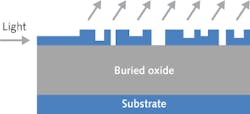Integrated-photonics systems often require coupling between the on-chip waveguide-based photonics and an optical fiber for input, output, or both. One common approach for fiber-grating couplers on silicon-on-insulator (SOI) materials is the creation of a one-dimensional grating on top of the waveguide, allowing diffraction of light into and out of the waveguide. As waveguides get smaller in cross section, however, this type of coupling grows less efficient due to the low-mode overlap between the waveguide and the fiber. Rather than trying to create a grating coupler based on a certain principle, researchers at Technische Universität Berlin (Berlin, Germany) and IHP GmbH (Frankfurt, Germany) are using two “metaheuristic” search methods (particle swarm and genetic algorithms) to home in on optimum grating configurations.
In an example run, 32 gratings are randomly generated and then simulated using a fully vectorial finite-element solver. The genetic algorithm usually got stuck in a local, rather than a global, optimum; the particle swarm usually found the global optimum but oscillated around the best point. The results often maintained at least an appearance of randomness. The resulting configurations had a theoretical coupling efficiency of as good as 1.1 dB at a 1.55 μm wavelength for a waveguide height of 200 nm with an epitaxial layer of 200 nm thickness. Contact Benjamin Wohlfeil at [email protected].
